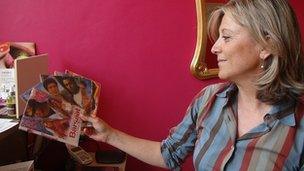Bollywood's expanding reach
- Published

The Bollywood Dance Ensemble is made up of Germans
With India's film industry celebrating its centenary, the BBC's Zubair Ahmed left Mumbai - the home of Bollywood - to discover the deep impact Indian cinema is making on non-Indian communities around the world.
It was biting cold outside a big auditorium in Hannover, Germany.
But inside, the atmosphere was sizzling as one after another, belly dancers enthralled the audience with their gyrations.
There was near commotion as the name of the group, the Bollywood Dance Ensemble, was announced - they had been eagerly awaited.
As the 15 white German women, dressed in Maharashtrian style sarees, began dancing the decibel level hit the roof as people whistled, clapped and yelled.
The women milked maximum applause from the audience. An awe-struck middle-aged German woman later told the group leader, Ferda Bas: "Your Bollywood dance was very impressive. Your dance was hot."
Though it was a festival of belly dance, it seems no ethnic cultural show in Germany is complete without Bollywood song and dance sequences thrown into it.
Bollywood is in demand in Germany, with women in particular seeming to be attracted to Hindi movies and songs.
There are many dance classes teaching Bollywood moves.

Abdullah is an amateur Bollywood singer by day
Ferda Bas has never been to India and yet she is synonymous with Bollywood in Hannover.
She teaches German girls Bollywood dance once a week and does her shows on stage every now and then.
"The girls want to know more about Bollywood now. The want to know about the meaning of songs and the dance. The more they dance the more they want to know," she says.
A German woman who watched Ferda Bas and her group's show said she was a big fan of Bollywood.
"I want to know everything about Bollywood, their costumes, their shoes, their clothes - everything."
'Emotions and freedom'
The growing demand for Hindi films and all thing Bollywood was recognised several years ago by Nasim Khan, a Cologne-based publisher of Indo-German parentage.
In 2006 he launched a glossy German-language Bollywood magazine called Ishq.
Germany was first properly introduced to Bollywood that same year when a private TV channel aired a hit Bollywood film, Kabhi Khushi Kabhi Gham.
Nasim Khan, who also partners with a Bollywood distribution company, said it was a surprise hit. "More than two million people watched it."
The movie had a huge impact on German women.
Julia Wessel, who edits Ishq magazine, and her mother were among those who watched the movie.
"It was like watching a train wreck. You just can't take your eyes off it and I had to watch it again when it was repeated," she said.
Julia believes the film touched an emotional chord with German women.
"My mum was watching it. She started crying and my mum is super tough. I had never seen her cry during a movie. Obviously it had an appeal for German women."

The Bollynails parlour is a hit in Marrakesh
But what really attracts them to Hindi movies?
A young German girl, Shanti, who looks like a youthful Aishwarya Rai, and who has seen more than 200 Bollywood movies, says: "It's colour, emotions and freedom which draws one to Bollywood."
Many German female fans of Bollywood I met said they loved the dance because it's sensuous and allowed them to express their womanhood with freedom.
But Nasim Khan summed it up rather nicely: "Bollywood is actually filling a gap that has existed in the Western society for 30-40 years.
"Let's say it's about passionate love, about romance, which is missing in Hollywood. It is strong on technology but a lot of feelings are gone. People want to cry, they want to laugh in this world. They are searching for these moments. Bollywood is filling these gaps."
Singing waiter
Cross the Mediterranean to North Africa and you detect the influence of Bollywood there as well.
Abdullah, in the bustling Medina of Marrakesh, is a waiter by night and an amateur Bollywood singer by day.
He keeps singing Hindi numbers, even greets his customers with Hindi songs. He has saved dozens of Bollywood songs on his mobile phone.
He told me in rather good Hindi he had been watching Hindi movies for 25 years.
"I love India. I love Indian people and I love Bollywood [and] the way it portrays religious harmony in India."
In Settat town near Casablanca, 25-year-old Amine grew up on a heavy dose of Bollywood movies.
Now he lives and works in Spain but his fascination for Bollywood has not diminished. He once cried watching the Hindi film, Kal Ho Na Ho.
"My friends said I was a woman. I challenged them to watch the movie and then pass judgment. At the end all of them were crying."
Some Moroccans are coming up with business ideas around Bollywood themes.
In an affluent suburb of Marrakesh, a French woman has named her trendy nail bar Bollynails, hoping to "cash in on the popularity of Bollywood in Morocco".

The Cinemaxx in Hanover shows Bollywood films
The city boasts a restaurant called Bombay. The interiors are designed in a Bollywood style.
When I walked in a Hindi number was playing. Here I discovered a Bollywood buff whose passion for Indian cinema seemed genuine.
Consider the reach of Bollywood: the restaurant owner was Moroccan, the manager French, the waiters from different parts of Africa. But their love for Bollywood had brought them all together.
'Global appeal'
Are Bollywood producers and directors aware their movies have such a powerful impact in these far corners of the world?
Director Imtiaz Ali has made several hit films.
"India has opened up to the world," he says.
"We are shooting in foreign locations more now. We are also using foreign talent. That's why our appeal is more global now."
The reach of Bollywood can also work in the other direction.
The craze for Bollywood movies is resulting in Western actors coming to Mumbai to look for roles.
Some have already made an appearances and it may not be long before we see them more often.
- Published23 March 2012